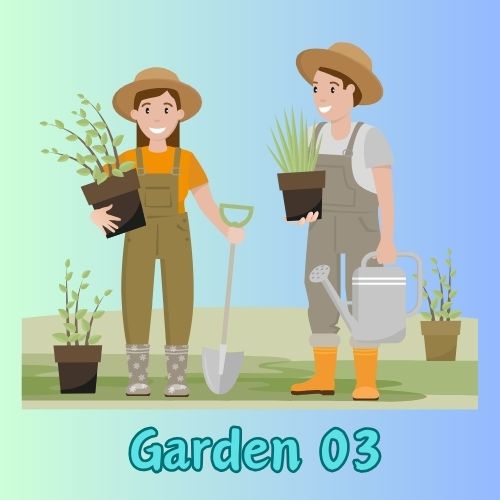Jasmine plants are known for their intoxicating fragrance and delicate, star-shaped blooms. They are popular among gardeners and plant enthusiasts due to their ability to thrive in various climates, while also offering an aesthetic appeal to homes and gardens. However, like any plant, jasmine requires the right care to flourish. One of the most critical aspects of jasmine plant care is proper fertilization. Applying the right fertilizer for jasmine plants can make a significant difference in the health, growth, and blooming capacity of your jasmine.
In this comprehensive guide, Garden 03 will explore everything you need to know about fertilizing jasmine plants—from the types of fertilizers to use, how to apply them, and expert tips for maximizing growth and blooms.
Why Fertilizing Jasmine is Essential
Jasmine plants are typically robust and can grow in various soil conditions, but to achieve optimal growth and abundant flowers, they need the right nutrients. Fertilization provides these nutrients, helping the plant to:
- Promote healthy root development: A well-fertilized jasmine plant can establish a strong root system that supports healthy overall growth.
- Encourage more blooms: Fertilizers with the right balance of nutrients, particularly phosphorus, are crucial for encouraging the production of flowers.
- Improve foliage growth: Healthy, green leaves indicate a well-nourished jasmine plant. Nitrogen in fertilizers supports vibrant foliage.
- Enhance disease resistance: A well-fertilized plant is better equipped to resist pests and diseases that may otherwise hinder growth.
Nutrient Requirements of Jasmine Plants
To understand the role of fertilizers, it’s essential to first know what nutrients jasmine plants need. Jasmine plants require the following nutrients:
- Nitrogen (N): Nitrogen is essential for leaf and stem growth. It is particularly important during the early growing stages of the jasmine plant.
- Phosphorus (P): Phosphorus helps with root development and flower production. It is crucial for creating a healthy, strong root system and for promoting an abundance of blooms.
- Potassium (K): Potassium supports overall plant health and helps in the development of strong stems. It also aids in water absorption and regulates various plant processes.
- Secondary Nutrients (Calcium, Magnesium, and Sulfur): These nutrients are important for overall health and can help the plant withstand environmental stress.
- Micronutrients: Nutrients like iron, manganese, zinc, copper, and boron, though required in small amounts, are essential for optimal plant growth.
Fertilizers provide these nutrients in varying ratios, so selecting the right one is key to achieving success with your jasmine plant.
Types of Fertilizer for Jasmine Plants

There are several types of fertilizers that you can use for jasmine plants. These vary based on their nutrient composition, release method, and how they interact with the soil and plant.
1. Organic Fertilizers
Organic fertilizers are derived from natural sources such as compost, manure, and bone meal. They release nutrients slowly over time, which can be beneficial for steady growth. Organic fertilizers also improve soil structure and support beneficial microbial activity.
- Compost: Compost is a rich source of organic matter that improves soil health and provides a balanced range of nutrients. It’s an excellent choice for jasmine plants, particularly when used as a top dressing or mixed into the soil during planting.
- Manure: Well-rotted animal manure provides a good mix of nitrogen, phosphorus, and potassium. It also adds organic matter to the soil, helping retain moisture.
- Bone Meal: Bone meal is an excellent source of phosphorus and calcium, two nutrients essential for flower production and root development.
2. Inorganic (Chemical) Fertilizers
Inorganic fertilizers are commercially produced and provide a specific ratio of nutrients. These fertilizers can offer immediate results due to their fast nutrient release.
- Balanced Fertilizers: A balanced fertilizer like 10-10-10 or 14-14-14 provides equal amounts of nitrogen, phosphorus, and potassium. This type is ideal for jasmine plants during their active growth stages.
- Bloom Boosters: Fertilizers high in phosphorus, such as 5-10-10, are ideal for promoting flowering. These are best used when the jasmine plant is preparing to bloom.
- Nitrogen-Rich Fertilizers: For foliage growth, especially in younger plants, a nitrogen-rich fertilizer like 20-10-10 can help develop lush green leaves.
3. Liquid Fertilizers
Liquid fertilizers are applied directly to the soil or as a foliar spray. They are fast-acting and are often used when plants show signs of nutrient deficiency or during the growing season to provide a quick nutrient boost.
- Fish Emulsion: A natural liquid fertilizer that provides a balanced ratio of nutrients, fish emulsion is often used for foliar feeding.
- Seaweed Extract: Seaweed extract is rich in micronutrients and can help improve the plant’s overall health. It’s a great addition to any fertilization regimen.
4. Slow-Release Fertilizers
Slow-release fertilizers provide a steady supply of nutrients over time. They are often granulated and release nutrients gradually as they break down. This reduces the need for frequent feeding and minimizes the risk of over-fertilization.
When to Fertilize Jasmine Plants
Timing is crucial when it comes to fertilizing jasmine plants. Fertilizing at the wrong time or over-fertilizing can lead to poor growth, reduced flowering, and other issues. Here’s when you should fertilize jasmine plants for the best results:
1. Spring
Spring is the most important time to fertilize jasmine plants. As the plant emerges from dormancy, it requires an extra boost of nutrients to support new growth. Applying a balanced or nitrogen-rich fertilizer in early spring will encourage the growth of healthy leaves and stems.
2. Summer
During the summer months, jasmine plants typically begin to produce flowers. At this stage, switch to a bloom-boosting fertilizer that is high in phosphorus to support flower production. Fertilize once every 4-6 weeks to encourage continuous blooming.
3. Fall
As fall approaches, jasmine plants begin to slow down their growth in preparation for winter dormancy. Fertilizing with a balanced or slow-release fertilizer in early fall can help the plant store nutrients for the winter. Avoid using high-nitrogen fertilizers during this period, as it may stimulate unnecessary growth that could be damaged by frost.
4. Winter
Jasmine plants generally do not need fertilization during the winter months when they are dormant. However, if you are growing jasmine indoors, you may continue light fertilization with a balanced fertilizer every 6-8 weeks.
How to Apply Fertilizer to Jasmine Plants
Proper application of fertilizer is as important as the type of fertilizer you choose. Over-fertilization can lead to nutrient imbalances, burnt roots, and poor plant health, while under-fertilization can result in weak growth and reduced blooming. Here’s how to correctly fertilize your jasmine plant:
1. Soil Application
For outdoor jasmine plants, apply granular fertilizers directly to the soil. Follow these steps:
- Step 1: Measure the appropriate amount of fertilizer according to the product’s instructions. Over-fertilizing can harm the plant, so be sure to follow the recommended guidelines.
- Step 2: Spread the fertilizer evenly around the base of the plant, avoiding direct contact with the stems or leaves to prevent burning.
- Step 3: Water the soil thoroughly after applying the fertilizer to help it penetrate the soil and reach the roots.
- Step 4: Reapply fertilizer as needed, depending on the growth stage and the type of fertilizer being used.
2. Foliar Feeding
Foliar feeding involves applying liquid fertilizer directly to the plant’s leaves. It’s an excellent method for providing a quick nutrient boost, especially when the plant shows signs of deficiency.
- Step 1: Dilute the liquid fertilizer according to the instructions.
- Step 2: Use a spray bottle or garden sprayer to apply the fertilizer to the leaves, focusing on the underside where nutrient absorption is most efficient.
- Step 3: Repeat the process every 2-3 weeks during the growing season.
3. Top Dressing with Compost or Organic Matter
Top dressing involves adding a layer of compost or organic matter around the base of the plant. This method helps enrich the soil with nutrients and improves its texture.
- Step 1: Spread a 1-2 inch layer of compost or well-rotted manure around the base of the plant.
- Step 2: Gently work it into the top layer of soil with a rake or your hands.
- Step 3: Water the plant thoroughly to help the nutrients reach the root zone.
Signs of Over-Fertilization and Under-Fertilization
Both over-fertilization and under-fertilization can lead to problems with jasmine plants. Here’s how to recognize and address these issues:
Over-Fertilization
Signs of over-fertilization include:
- Leaf burn: Brown or yellow edges on the leaves indicate fertilizer burn.
- Reduced blooming: Over-fertilizing, especially with nitrogen, can result in lots of foliage but few flowers.
- Salt build-up: Excess fertilizer can lead to a white, crusty build-up on the soil surface.
To fix over-fertilization, flush the soil with plenty of water to wash away excess nutrients. Stop fertilizing for several weeks and monitor the plant’s recovery.
Under-Fertilization
Signs of under-fertilization include:
- Yellowing leaves: Nitrogen deficiency can cause older leaves to yellow and fall off.
- Poor growth: Slow or stunted growth may indicate a lack of nutrients.
- Weak blooms A lack of phosphorus: can result in fewer and smaller blooms.
To address under-fertilization, apply a balanced fertilizer or one specifically designed to address the deficient nutrient. Follow the recommended application rates, and monitor the plant closely for signs of improvement.
Tips for Maximizing Jasmine Growth and Blooms
In addition to fertilizing, there are several other tips that can help your jasmine plant thrive:
1. Provide Adequate Sunlight
Jasmine plants love sunlight and require at least 4-6 hours of direct sunlight per day. However, in particularly hot climates, some partial shade during the hottest parts of the day can prevent leaf scorching. Place your jasmine in a spot where it gets plenty of morning sunlight, as this is generally less intense than the afternoon sun.
2. Water Properly
Jasmine plants prefer consistently moist soil, but they don’t like to sit in water. Make sure the soil is well-draining, and water the plant regularly, especially during dry periods. Overwatering can lead to root rot, while underwatering can stress the plant and reduce flowering.
3. Prune Regularly
Pruning jasmine plants encourages bushier growth and more blooms. Trim back any dead or weak stems in the early spring, and lightly prune the plant after each flowering cycle to promote more buds. Be careful not to over-prune, as jasmine flowers on the previous year’s growth.
4. Mulch to Retain Moisture
Applying a layer of organic mulch around the base of your jasmine plant can help retain soil moisture, regulate soil temperature, and reduce weed growth. Use organic materials such as bark, compost, or straw, and refresh the mulch as needed.
5. Control Pests and Diseases
Jasmine plants can occasionally suffer from pests like aphids, spider mites, and whiteflies. Regularly inspect your plant for signs of infestation, such as discolored leaves, sticky residue, or webbing. Treat pests with insecticidal soap or neem oil, and remove any severely damaged leaves to prevent the spread of disease.
Conclusion
Fertilizing your jasmine plant is one of the most important steps in ensuring that it grows strong and healthy, producing plenty of beautiful and fragrant blooms. By understanding the nutrient needs of jasmine, choosing the right fertilizer, and applying it at the correct times, you can keep your plant thriving throughout the growing season.
Whether you opt for organic fertilizers like compost and fish emulsion or choose a commercial bloom booster, always be mindful of your plant’s growth stage and nutrient requirements. With proper care and attention, your jasmine plant will reward you with its captivating beauty and fragrance for many seasons to come.
By following the tips and recommendations in this guide, you’ll not only enhance your jasmine’s overall health but also enjoy a garden filled with lush foliage and abundant blooms.





